The Marlin 1895 Trapper is everything you'd want in a lever gun. Tanner Denton
We may earn revenue from the products available on this page and participate in affiliate programs. Learn More ›
The Marlin 1895 Trapper is a delightful reminder of why lever guns continue to enjoy such popularity. It is a nimble rifle that embodies all the qualities that lever-action fans associate with the platform. But it’s not just a relic of some bygone era. The Trapper is a remarkably relevant rifle that strikes a balance between tradition and the expectations that today’s shooters have for the firearms they use.
At this point the big news that Marlin is flourishing under Ruger is old news. We’ve extolled the virtues of the Ruger-made Marlin 1895 SBL and crowned the Marlin 336 Classic as this year’s editor’s choice among new rifles. They are rightfully considered the best factory-produced Marlins ever. The Marlin 1895 Trapper keeps the winning streak going.
Marlin 1895 Trapper Specs
- Action: Lever-action
- Cartridge: .45/70 Gov’t
- Capacity: 5+1
- Weight: 6 pounds, 12 ounces
- Trigger: 5 pounds, 8 ounces
- Barrel: 16.1 inches, stainless threaded 11/16-24
- Stock: Dark gray laminate
- Sights: Skinner peep sights
- Length: 34.25 inches
- Price: $1,449
What the Marlin 1895 Trapper Is Designed for
“Trapper” model lever actions are characterized by their short barrels and compact dimensions. This is to make the rifle easy to sling through thick brush and rough country and then be employed in close quarters, whether dealing with a stubborn bull moose or an aggressive grizzly.
These qualities don’t just appeal to those working in the fur trade or animal control, however. Hunters who prefer to slip through dark timber, stands of young poplar, and willow thickets hoping to jump an elk, moose, or whitetail will appreciate the Trapper’s virtues. The same goes for hunters in tree stands or ground blinds where the shots are close and the need for maneuverability is paramount.
In this spirit, the Marlin 1895 Trapper comes with a 16.17-inch barrel, is just over 34 inches long, has a laminate wood stock and stainless-steel metal work for durability, is equipped with open peep sights, and is chambered in the thumping .45/70 Gov’t.
Marlin 1895 Trapper Ergonomics
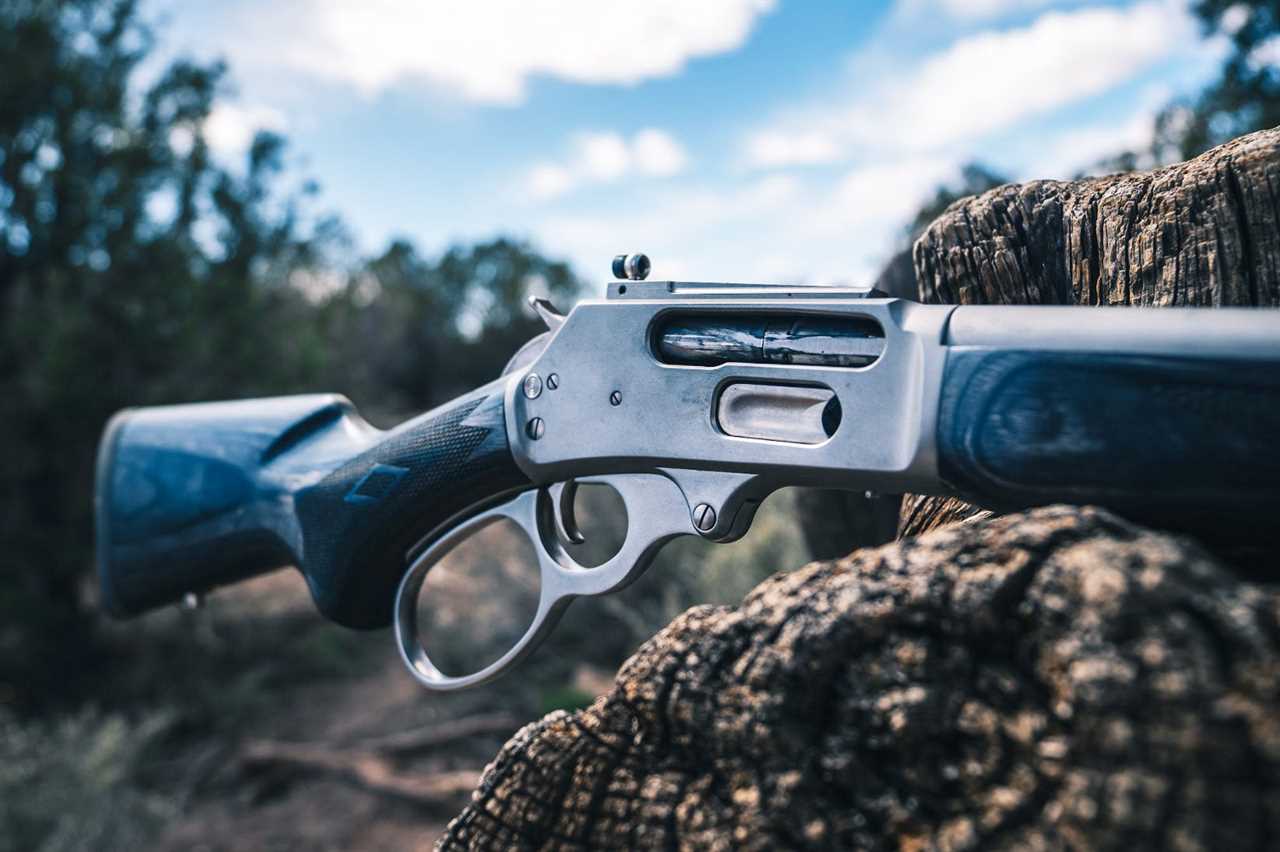
The Trapper had excellent ergonomics and handling. Tanner Denton
The Marlin 1895 has been with us for a long time—if I have to tell you how long that’s been you probably shouldn’t own a gun—and is a known quantity. Early on Marlin offered the 1895 in compact models including a carbine with a 22-inch barrel and an even shorter rifle with a 15-inch barrel and a saddle ring on the left side of the receiver.
These weren’t called “Trappers”—that is a modern term—but they scratched the same itch. Incidentally, this goes for Winchester Trappers too. Early Winchester 92s and 94s with short barrels and saddle rings, for instance, were known as “Baby Carbines” or “Special Short Carbines.” Winchester didn’t produce “Trappers” until much later.
Lively Handling
I hate to follow the herd and describe the Trapper as “handy”—nearly every lever-action review trots out that adjective—but it is apt. The trim receiver allows you to wrap your hand pretty much all the way around the action for nearly effortless carry. The point of balance on the 6.75-pound rifle is right below the loading gate so hauling the rifle around single-handed is simple.
That same smooth and easy balance is experienced when shouldering the rifle. The Marlin 1895 Trapper’s weight settles nicely between the hands. The muzzle gets on target fast and transitions from one target to another quickly without feeling whippy. This quality has resonated with generations of shooters and is a key reason the platform endures.
Smooth Cycling
Acquiring targets in a flash doesn’t do you any good if your rifle runs like a fat kid chasing an ice cream truck. The action on our sample has been smooth and easy to manipulate since we first got it. At this point we have a few hundred rounds through the rifle and have never cleaned it. The action hasn’t lost a step.
The only issue we encountered was ammo specific. The crimp on Hornady’s 325-grain FTX load would catch slightly while feeding—but that’s an issue with the ammo, not the rifle. Everything else fed flawlessly.
The oversized lever-loop has radiused surfaces that minimize the “bite” experienced while running the action, especially if you aren’t wearing gloves. While big loops are popular, and look cool, they don’t actually help you run a lever-action faster. The opposite is true, in fact. The extra distance the trigger hand needs to move to engage the loop is time lost—but unless you’re a competitive cowboy action shooter you won’t notice the difference. And did I mention that they look cool?
Marlin 1895 Trapper Accuracy
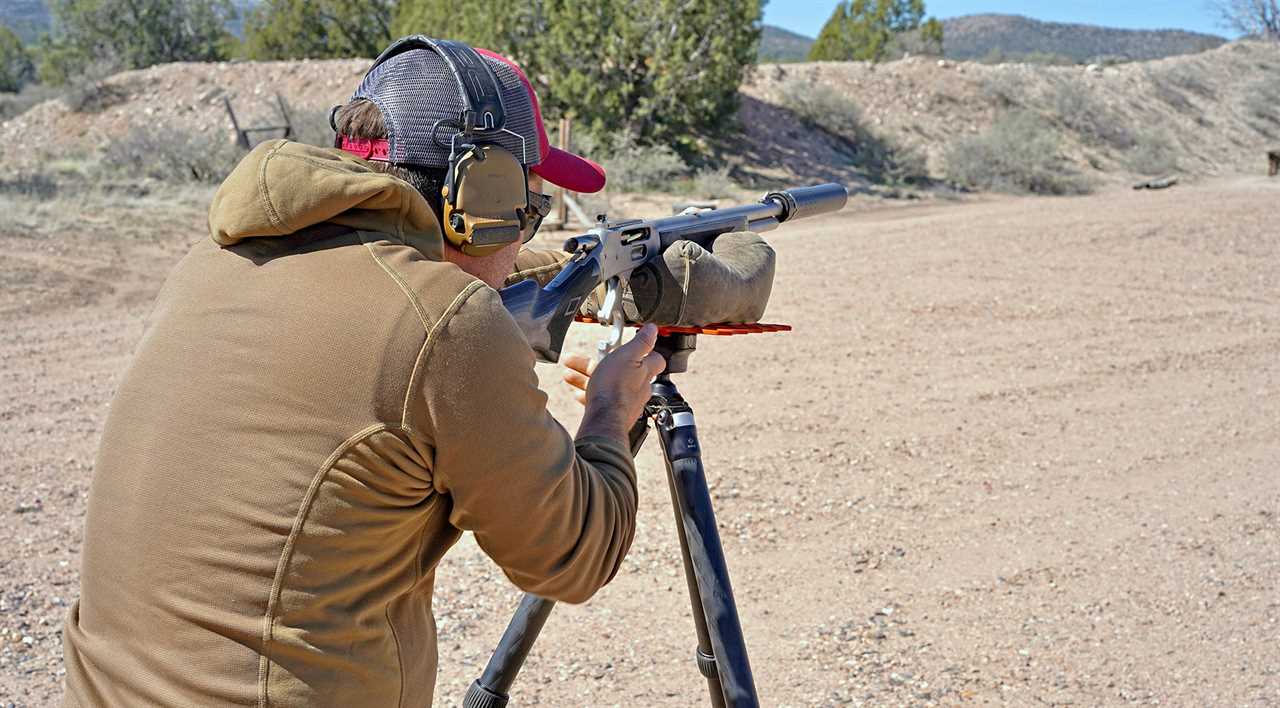
We shot the Marlin 1895 Trapper at 50 and 100 yards. Scott Einsmann
Not only does the Trapper get rounds downrange at a brisk pace, it does a pretty good job of hitting what you’re aiming at. It comes with a set of high-quality adjustable Skinner sights, which are optimized for fast, close shooting—think Cape buffalo charging in shoulder-high grass—but that are capable of reasonable accuracy at greater distances.
The sights consist of a rear aperture ghost ring and a white ramp front post. The rear sight includes an insert that can be threaded in to create a smaller—and more precise—opening, and that’s what we used while shooting groups.
We tested the Marlin’s open sights at 50 yards and our five-shot groups averaged 2.945 inches. Even at 100 yards we were able to keep five shots in a 5-inch circle, which is good enough for deer, moose, elk, and other large game.
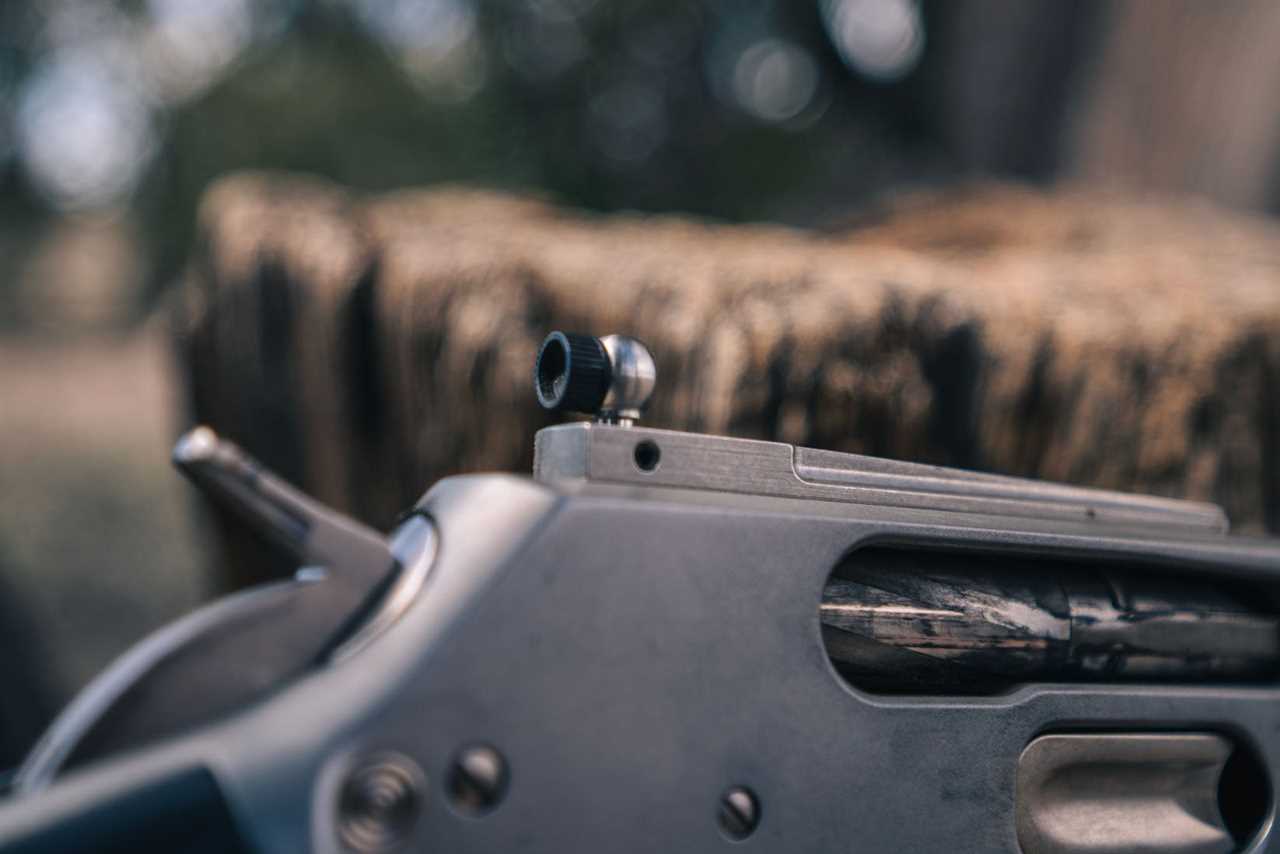
The Skinner sights on the trapper made for reasonably accurate shooting at 50 and 100 yards. Tanner Denton
Typical Lever-Action Trigger
The trigger on our sample broke at 5 pounds, 8 ounces. While that would lead to torn ligaments in the trigger finger of a precision rifle shooter, it isn’t bad for a lever action. The pull weight is mitigated some by the Marlin’s crisp break. The trigger has no mush or creep. Once you apply that 5.5 pounds of pressure, it snaps cleanly.
.45/70 Gov’t Recoil
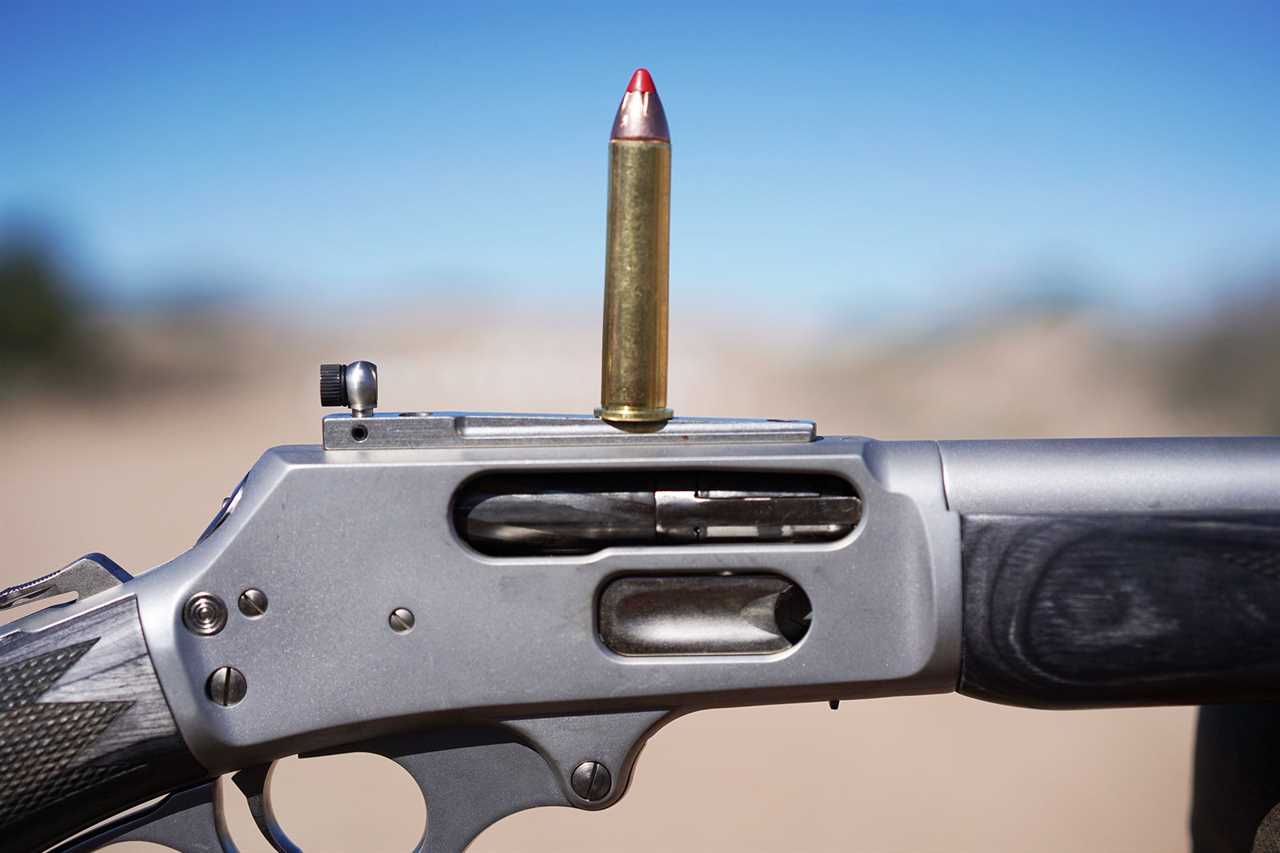
The old .45-70 Govt. creates stout recoil. Scott Einsmann
Combine the more potent .45/70 rounds out there with the Marlin 1895 Trapper’s 6-pound, 12-ounce weight and a few shots will knock the wax out of your ears. The thick rubber recoil pad on the butt stock helps with that, but I called this rifle a thumper for a reason.
With milder loads the recoil isn’t bad but when it comes to managing the Trapper—or any big lever action—you want to drive the rifle hard. To control the rifle and reduce the slap you need to hang on tight. Employ a strong grip on the fore-end and pull the rifle firmly back into the crease between your shoulder and chest muscles.
Suppressor Friendly
We put a Silencer Co. Hybrid .46-caliber suppressor on our rifle for much of our testing.
That can is a hefty brute—it weighs 19.2 ounces—and alters how the Trapper handles. It shifts the balance forward and you can feel a lot more of the rifle’s weight in your lead hand.
In terms of speed to target it slows the gun down a touch, no doubt about it. But because the rifle is so compact to begin with the effect is less than you’d otherwise expect.
The extra weight combined with the recoil-diminishing qualities of a suppressor (more due to the reduction in muzzle blast than actual felt kick) tamed the Trapper to a remarkable degree.
We ran the rifle until the Silencer Co. Hybrid was hot enough to brand cattle, we were having so much fun.
Also, because the sights on the rifle are fairly tall the suppressor didn’t obscure the top of the front post sight. Being able to run a can and still get a clear sight picture is a nice benefit.
Operating the Marlin 1895 Trapper
The manual of arms for the Trapper is the same as for any 1895 ever made. The side loading gate accommodates up to five of the stubby .45/70 rounds. Racking the lever chambers a cartridge and cocks the hammer. The crossbolt safety, when engaged, prevents the rifle from firing even when the trigger is pulled causing the hammer to fall. Pushing the safety in with your trigger finger before shooting needs to be practiced until the motion is automatic. Alternatively, you can do what generations of lever-action shooters have done before Marlin added the crossbolt safety to their rifles in 1984 and disregard it. Instead, you can keep the hammer down or at half cock and thumb it back when it is time to take the shot like every cowboy, buffalo hunter, and Comanche warrior did.
To unload the rifle, you need to shuck the action until all the cartridges flop out of the side ejection port.
Marlin 1895 Trapper Craftsmanship
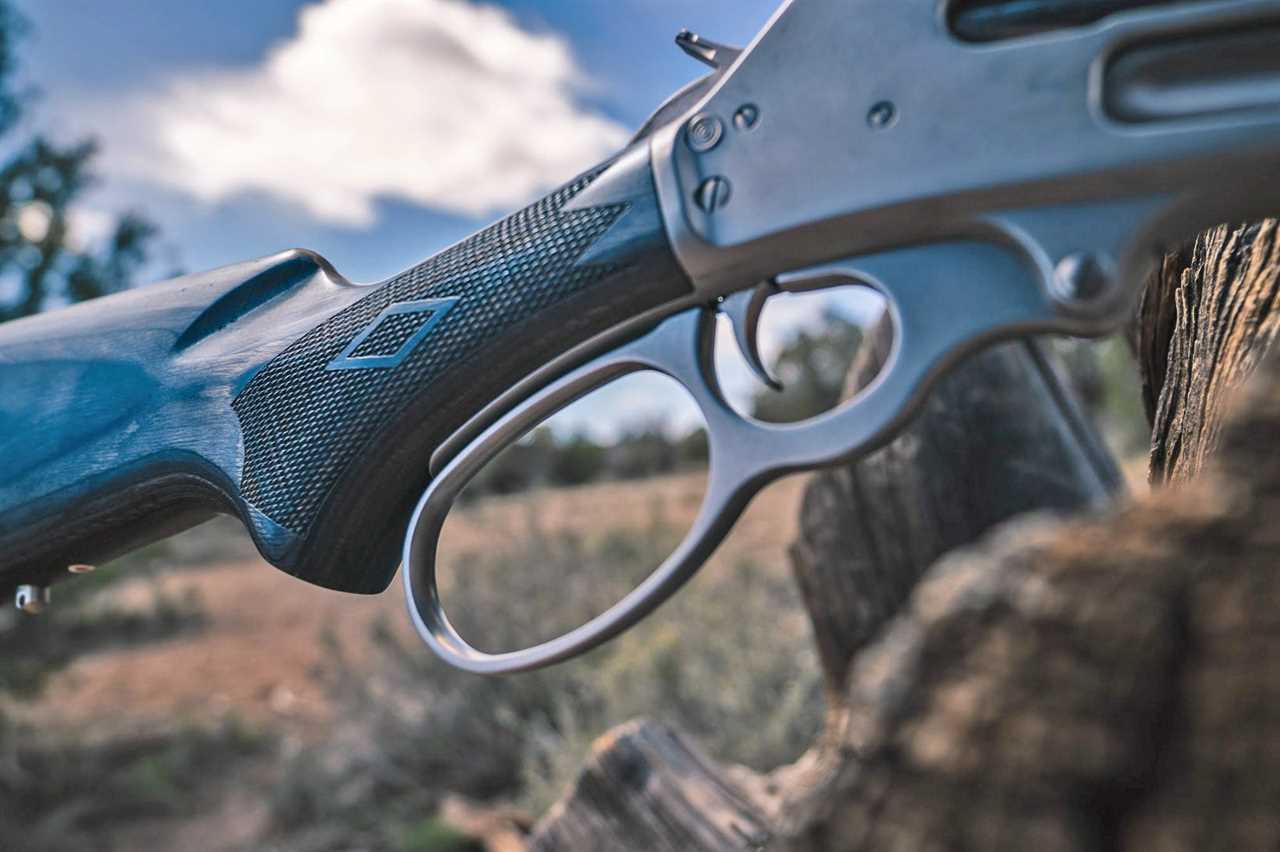
The Marlin Trapper features a large lever-loop and nice checkering. Tanner Denton
The quality of the new Ruger-built Marlins I’ve shot is impressive. Everything on these guns is tighter, runs smoother, fits better, and looks nicer. There’s a lot of nostalgia for the old North Haven, Connecticut, Marlins and I get that. I grew up not far from the factory—in the town of Branford—so Marlin was my hometown gun. But the fact is that these new Marlins being produced in Mayodan, North Carolina, are superior by every metric.
Marlin 1895 Trapper Stock

The iconic Marlin logo is cut on the bottom of the grip. Tanner Denton
The dark gray laminate stock on the Trapper has a purposeful, utilitarian look that is in keeping with the functional satin finish on the stainless barrel, receiver, and tubular magazine. The rifle is handsome, but not fancy. It’s the kind of gun you’re happy to show off at the range but won’t hesitate to take on a march through a bog.
The laser-cut checkering is done in a classic diamond pattern. Cutting sharp, defined diamonds on laminate is difficult, and the ones on this Marlin are about as good as it gets on a production rifle. The grip they afford is excellent, however.
The fore-end is reasonably trim and fits precisely within the fore-end tip. The buttstock is also inlet so that it mates with the receiver and trigger plate with no gaps or inconsistencies. Likewise, the recoil pad is attached to the buttstock in a clean fashion—though you can see evidence of sanding on the spacer between the stock and recoil pad.
The underside of the stock incorporates the signature Marlin bullseye and the bottom of the grip is cut with an image of the famous Marlin horseback rider logo. Both are nice touches.
Even after a few hundred rounds of shooting, the stock is still tight and betrays no hint of a wiggle.
Metalwork
The satin finish on the metal is even across all the components. Often when you look closely at a rifle, you’ll see that the finish on the barrel might not match the finish on the receiver or on the muzzle protector, because those parts are sometimes sourced from different companies.
That’s not the case with this Marlin. Everything matches, which is gratifying for those who obsess over such details.
I can also tell that the workers at the Marlin factory are getting better at polishing the receivers, which is a difficult task to master. When metal is over polished you end up with soft, ill-defined edges. The flats on the receiver of the Trapper were sharp and done correctly.
Final Thoughts on the Marlin 1895 Trapper
On the one hand, few of us really “need” a .45/70 Gov’t. And even among .45/70s the Trapper falls into a small niche—a subset within a subset. But thank goodness we don’t live in a world where “need” rules the day.
Some guns have a certain charisma—an “it” factor that draws us to them. The Marlin 1895 Trapper is one of them. Everyone on the test team who shot it—there were seven of us total who had trigger-time with the Trapper—really enjoyed the experience, especially once we took advantage of its ability to host a suppressor.
So whether you’re going to charge into a darkened cave to root out a sloth bear, give that 80-pound whitetail who’s been nibbling your shrubbery all summer what-for come November, or just want to own a classic gun in a classic caliber because you feel like it—I doubt you’d be disappointed after adding a Marlin 1895 Trapper to your collection.
The post Marlin 1895 Trapper, Tested and Reviewed appeared first on Outdoor Life.
Articles may contain affiliate links which enable us to share in the revenue of any purchases made.
By: John B. Snow
Title: Marlin 1895 Trapper, Tested and Reviewed
Sourced From: www.outdoorlife.com/guns/marlin-1895-trapper-review/
Published Date: Wed, 31 May 2023 18:26:43 +0000
----------------------------------------------
Did you miss our previous article...
https://manstuffnews.com/weekend-warriors/amelia-earhart-on-flying-and-flyfishing-from-the-archives
 Backyard GrillingWeekend WarriorsAdvice from DadBeard GroomingTV Shows for Guys4x4 Off-Road CarsMens FashionSports NewsAncient Archeology World NewsPrivacy PolicyTerms And Conditions
Backyard GrillingWeekend WarriorsAdvice from DadBeard GroomingTV Shows for Guys4x4 Off-Road CarsMens FashionSports NewsAncient Archeology World NewsPrivacy PolicyTerms And Conditions
